


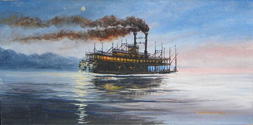
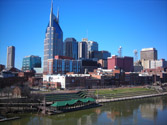
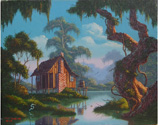
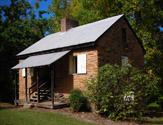









Sunbelt Excursions
The Ryman Auditorium . . . More Than Just the Mother Church of Country Music
No trip to Nashville would be complete without including the historic Ryman Auditorium on the itinerary. Once described as "America's most picturesque institution" by Bob Hope, the Ryman offers daily tours, and its stage has been graced by recording artists, entertainers and orators ranging from Hank Williams, Patsy Cline, Sheryl Crow and John Mayer to Paderewski, Rachmaninoff, Booker T. Washington and Theodore Roosevelt. Whether you opt for the self-guided tour or take in a show, you are sure to go away with a greater understanding of the integral role the "Carnegie Hall of the South" has played in establishing Nashville as Music City, USA.
Situated in the heart of downtown just off Broadway at 116 Fifth Avenue North, the Ryman is across the street from the convention center and within easy walking distance of the Country Music Hall of Fame, Gaylord Entertainment Center, Hard Rock Cafe, Wildhorse Saloon, Riverfront Park and many other Music City attractions as well as hotels and popular restaurants.
The Gospel According to Sam Jones
The Ryman's significance in Nashville's illustrious past is immeasurable, but the building was not always associated with country music. In fact, the "Mother Church of Country Music" was once just that---a church. The Ryman was first known as the Union Gospel Tabernacle, had no denominational affiliation and wound up hosting famous preachers and evangelists like T. DeWitt Talmadge and Dwight L. Moody.
The Gospel According to Sam Jones
The Ryman's significance in Nashville's illustrious past is immeasurable, but the building was not always associated with country music. In fact, the "Mother Church of Country Music" was once just that---a church. The Ryman was first known as the Union Gospel Tabernacle, had no denominational affiliation and wound up hosting famous preachers and evangelists like T. DeWitt Talmadge and Dwight L. Moody.
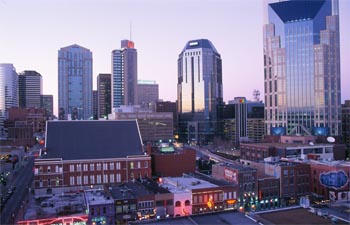
Photograph by Barry M. Winiker(Courtesy of the Nashville Convention & Visitors Bureau)
Before the existence of the Union Gospel Tabernacle, Samuel Porter Jones, a fiery, flamboyant minister, began preaching in Nashville in the late 1800s, and for good reason. Increased poverty, a spike in crime and the influx of gambling houses, saloons and brothels accompanied the city's ensuing population explosion. Even among those occupying lower Broadway and its vicinity---an area evangelist Billy Sunday would, decades later, describe as "the devil's backbone"---Jones' revivals stirred hearts, prompted numerous conversions and promoted a renewal of faith and clean living.
It was at one of Rev. Jones' meetings that Thomas Green Ryman and some friends attended with the sole intention of heckling the service. Instead, the men were convicted by the Holy Spirit and left as born-again Christians! Ryman, a riverboat captain, owned the Ryman Line Riverboat Company as well as saloons on Broad Street. Reportedly on the same day as their conversion, Ryman and his friends retrieved all the whiskey from his saloons and emptied the booze into the Cumberland River. Legend has it that "even the fish got tipsy."
Soon, Ryman would approach Rev. Jones to discuss the building of a "Tabernacle for all denominations," but it would take several years of fundraising before construction of the Union Gospel Tabernacle would begin. Nonetheless, their persistence and dedication paid off, and the Tabernacle was completed in 1892. However, it lacked a major component of the original architectural plans---its balcony. In 1897, a Confederate Veterans reunion drew nearly a hundred thousand conventioneers to Nashville. The Union Gospel Tabernacle served as the meeting's headquarters, and the sum of $10,000 needed to add the balcony was donated by the veterans. The balcony was named the Confederate Gallery in their honor.
Following the death of Thomas Ryman in 1904, the tabernacle was renamed the Ryman Auditorium. With $9,000 of the original $100,000 debt still owed, a monumental concert by the Metropolitan Opera would ultimately earn enough profits to eliminate the Ryman's final debt.
Over the next few years, the Ryman Auditorium played host to various events, solidifying its stature as Nashville's premier venue.
It was at one of Rev. Jones' meetings that Thomas Green Ryman and some friends attended with the sole intention of heckling the service. Instead, the men were convicted by the Holy Spirit and left as born-again Christians! Ryman, a riverboat captain, owned the Ryman Line Riverboat Company as well as saloons on Broad Street. Reportedly on the same day as their conversion, Ryman and his friends retrieved all the whiskey from his saloons and emptied the booze into the Cumberland River. Legend has it that "even the fish got tipsy."
Soon, Ryman would approach Rev. Jones to discuss the building of a "Tabernacle for all denominations," but it would take several years of fundraising before construction of the Union Gospel Tabernacle would begin. Nonetheless, their persistence and dedication paid off, and the Tabernacle was completed in 1892. However, it lacked a major component of the original architectural plans---its balcony. In 1897, a Confederate Veterans reunion drew nearly a hundred thousand conventioneers to Nashville. The Union Gospel Tabernacle served as the meeting's headquarters, and the sum of $10,000 needed to add the balcony was donated by the veterans. The balcony was named the Confederate Gallery in their honor.
Following the death of Thomas Ryman in 1904, the tabernacle was renamed the Ryman Auditorium. With $9,000 of the original $100,000 debt still owed, a monumental concert by the Metropolitan Opera would ultimately earn enough profits to eliminate the Ryman's final debt.
Over the next few years, the Ryman Auditorium played host to various events, solidifying its stature as Nashville's premier venue.
The Grand Ole Opry
In 1925, the Grand Ole Opry began as the WSM Barn Dance. Broadcasting from a downtown Nashville radio station owned by the National Life and Accident Insurance Company, the program hosted by George D. Hay would enjoy phenomenal success and international fame. It wasn't until 1927 that Hay coined the name Grand Ole Opry following the broadcast of a symphony. The name stuck, and the show moved from venue to venue to accommodate its growing audience before settling at the Ryman in 1943. Country music icons and legends, including Hank Williams, Patsy Cline, Dottie West, Tennessee Ernie Ford, Johnny Cash, Loretta Lynn, the Carter Family, Martha Carson and Porter Wagoner, had collectively entertained generations of fans by the time the Opry moved from the Ryman in 1974.
"O, The Glory Did Roll!"
Like country music fans, connoisseurs of southern gospel hold the Ryman in high esteem. After all, it was here that great quartets and family groups like Hovie Lister & The Statesmen, the Speer Family, the Blackwood Brothers and The LeFevres used to share the same billing and sing the glory down well into the early morning hours. The monthly Wally Fowler All-Night Gospel Sing, first held in 1948, was enjoyed well beyond the confines of the Ryman's walls by WSM listeners in the far reaches of America.
More recently, Christian music mogul Bill Gaither (who, in part, attributes his life-long passion for southern gospel to the Wally Fowler concerts he attended as a boy) has brought much attention to the Ryman through several of his phenomenally successful Homecoming recordings. Gaither's Ryman Gospel Reunion, a platinum-selling video, included clips of southern gospel legends fondly reminiscing of those all-night gospel singings. And The Cathedrals' A Farewell Celebration and The Happy Goodmans' 50 Years were also top sellers from the Gaither series. These three projects, all recorded live at the Ryman, ably captured the intimate ambience one can only experience in a concert setting at the famous Nashville landmark.
" . . . Hungry for Good Music"
In 1999, Nashville-based Cumberland House published an excellent book titled Unbroken Circle: A Quotable History of the Grand Ole Opry. The book, edited by Randall Bedwell, contains various quotes from recording artists, industry professionals and even a few fans. One chapter is devoted solely to the Ryman Auditorium. Describing the inevitable effect the Ryman had on him, musician Tom T. Hall once stated, "The polished wooden pews sat glistening in the afternoon sun that filtered through the windows and gave the aroma of a thousand old guitars. There's nothing else like it. It makes you hungry for good music."
And there's no question about it. Good music and the Ryman Auditorium go hand in hand.
In 1925, the Grand Ole Opry began as the WSM Barn Dance. Broadcasting from a downtown Nashville radio station owned by the National Life and Accident Insurance Company, the program hosted by George D. Hay would enjoy phenomenal success and international fame. It wasn't until 1927 that Hay coined the name Grand Ole Opry following the broadcast of a symphony. The name stuck, and the show moved from venue to venue to accommodate its growing audience before settling at the Ryman in 1943. Country music icons and legends, including Hank Williams, Patsy Cline, Dottie West, Tennessee Ernie Ford, Johnny Cash, Loretta Lynn, the Carter Family, Martha Carson and Porter Wagoner, had collectively entertained generations of fans by the time the Opry moved from the Ryman in 1974.
"O, The Glory Did Roll!"
Like country music fans, connoisseurs of southern gospel hold the Ryman in high esteem. After all, it was here that great quartets and family groups like Hovie Lister & The Statesmen, the Speer Family, the Blackwood Brothers and The LeFevres used to share the same billing and sing the glory down well into the early morning hours. The monthly Wally Fowler All-Night Gospel Sing, first held in 1948, was enjoyed well beyond the confines of the Ryman's walls by WSM listeners in the far reaches of America.
More recently, Christian music mogul Bill Gaither (who, in part, attributes his life-long passion for southern gospel to the Wally Fowler concerts he attended as a boy) has brought much attention to the Ryman through several of his phenomenally successful Homecoming recordings. Gaither's Ryman Gospel Reunion, a platinum-selling video, included clips of southern gospel legends fondly reminiscing of those all-night gospel singings. And The Cathedrals' A Farewell Celebration and The Happy Goodmans' 50 Years were also top sellers from the Gaither series. These three projects, all recorded live at the Ryman, ably captured the intimate ambience one can only experience in a concert setting at the famous Nashville landmark.
" . . . Hungry for Good Music"
In 1999, Nashville-based Cumberland House published an excellent book titled Unbroken Circle: A Quotable History of the Grand Ole Opry. The book, edited by Randall Bedwell, contains various quotes from recording artists, industry professionals and even a few fans. One chapter is devoted solely to the Ryman Auditorium. Describing the inevitable effect the Ryman had on him, musician Tom T. Hall once stated, "The polished wooden pews sat glistening in the afternoon sun that filtered through the windows and gave the aroma of a thousand old guitars. There's nothing else like it. It makes you hungry for good music."
And there's no question about it. Good music and the Ryman Auditorium go hand in hand.
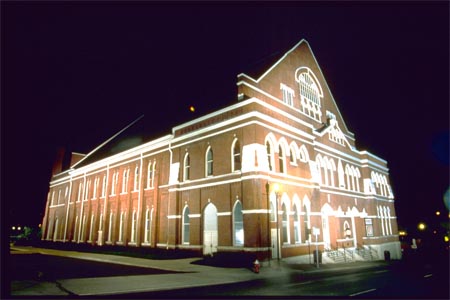
Photograph by Donnie Beauchamp (Courtesy of NCVB)
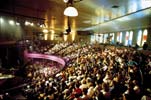
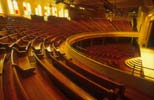

These photographs courtesy of the Ryman Auditorium. The Ryman Auditorium is a Gaylord Entertainment company.
Both an historic landmark and functioning venue, the Ryman Auditorium proves to be a memorable destination for thousands of tourists and music fans each year. Visitors can pose for photos with the Ryman's famous stage as a backdrop or have their picture taken with the bronze statue of Roy Acuff and Minnie Pearl! Furnishings and architectural features have been maintained and preserved through the decades, ensuring the Ryman's historical integrity has been compromised as little as possible. Highlights include the building's beautiful oak pews (built by the Indiana Church Furnishing Company in 1897), ironwork (built by the Louisville Bridge Company in 1896), colorful stained glass windows and, of course, the Confederate Gallery balcony.
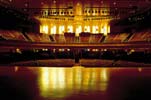
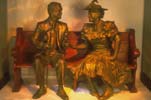
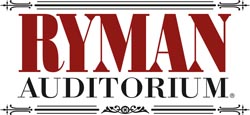
When planning a visit to the Ryman Auditorium, be sure to keep in mind these nearby hotels, restaurants and attractions:
Hotels
Courtyard by Marriott Nashville Downtown, 170 Fourth Avenue North, Tel: (615) 256-0900
Doubletree Hotel Nashville, 315 Fourth Avenue North, Tel: (615) 244-8200
Hampton Inn & Suites Nashville Downtown, 310 Fourth Avenue South, Tel: (615) 277-5000
Hilton Nashville Downtown Hotel, 121 Fourth Avenue South, Tel: (615) 242-5675
Holiday Inn Express, 920 Broadway, Tel: (615) 244-0150
Renaissance Nashville Hotel, 611 Commerce Street, Tel: (615) 255-8400
Union Station--A Wyndham Historic Hotel, 1001 Broadway, Tel: (615) 726-1001
Westin Hermitage Hotel, 231 Sixth Avenue North, Tel: (615) 244-3121
Dining
Arthur's (at Union Station), Continental, 1001 Broadway, Tel: (615) 255-1494
Bourbon Street Blues and Boogie Bar, 220 Printers Alley, Tel: (615) 242-5837
Capitol Grille and Oak Bar (at Westin Hermitage Hotel), American, 231 Sixth Avenue North, Tel: (615) 345-7116
Hard Rock Cafe, American, 100 Broadway, Tel: (615) 742-9900
Jack's Bar-B-Que, 416 Broadway, Tel: (615) 254-5715
Wildhorse Saloon, Southern, 120 Second Avenue North, Tel: (615) 902-8200
Other Attractions
Country Music Hall of Fame, 222 Fifth Avenue South, Tel: (615) 416-2001
Ernest Tubb Record Shop, 417 Broadway, Tel: (615) 255-7503
Forth Nashborough, Riverfront Park, 170 First Avenue North
Frist Center for the Visual Arts, 919 Broadway, Tel: (615) 244-3340
Schermerhorn Symphony Center, One Symphony Place
Tennessee State Museum, Fifth Avenue (between Union and Deaderick), Tel: (615) 741-2692
Wildhorse Saloon, 120 Second Avenue North, Tel: (615) 902-8200
Hotels
Courtyard by Marriott Nashville Downtown, 170 Fourth Avenue North, Tel: (615) 256-0900
Doubletree Hotel Nashville, 315 Fourth Avenue North, Tel: (615) 244-8200
Hampton Inn & Suites Nashville Downtown, 310 Fourth Avenue South, Tel: (615) 277-5000
Hilton Nashville Downtown Hotel, 121 Fourth Avenue South, Tel: (615) 242-5675
Holiday Inn Express, 920 Broadway, Tel: (615) 244-0150
Renaissance Nashville Hotel, 611 Commerce Street, Tel: (615) 255-8400
Union Station--A Wyndham Historic Hotel, 1001 Broadway, Tel: (615) 726-1001
Westin Hermitage Hotel, 231 Sixth Avenue North, Tel: (615) 244-3121
Dining
Arthur's (at Union Station), Continental, 1001 Broadway, Tel: (615) 255-1494
Bourbon Street Blues and Boogie Bar, 220 Printers Alley, Tel: (615) 242-5837
Capitol Grille and Oak Bar (at Westin Hermitage Hotel), American, 231 Sixth Avenue North, Tel: (615) 345-7116
Hard Rock Cafe, American, 100 Broadway, Tel: (615) 742-9900
Jack's Bar-B-Que, 416 Broadway, Tel: (615) 254-5715
Wildhorse Saloon, Southern, 120 Second Avenue North, Tel: (615) 902-8200
Other Attractions
Country Music Hall of Fame, 222 Fifth Avenue South, Tel: (615) 416-2001
Ernest Tubb Record Shop, 417 Broadway, Tel: (615) 255-7503
Forth Nashborough, Riverfront Park, 170 First Avenue North
Frist Center for the Visual Arts, 919 Broadway, Tel: (615) 244-3340
Schermerhorn Symphony Center, One Symphony Place
Tennessee State Museum, Fifth Avenue (between Union and Deaderick), Tel: (615) 741-2692
Wildhorse Saloon, 120 Second Avenue North, Tel: (615) 902-8200
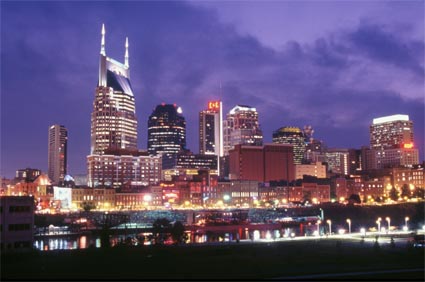
Photograph by Gary Layda(Courtesy of NCVB)
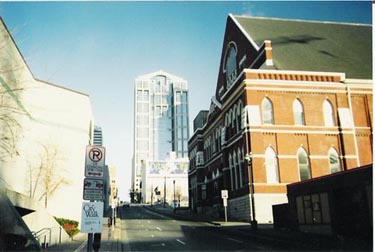
As I recall . . .
On February 4-5, 2000, I attended the Gospel Music Association's Academy of Gospel Music Arts educational seminars in downtown Nashville. While in town, I had the pleasure of seeing Grammy winner Ashley Cleveland perform in concert, and was able to leisurely enjoy much of the downtown scenery. Before breakfast on Sunday, February 6, I left my hotel on Broadway with camera in hand and walked several blocks toward the river. I was determined to get some snapshots of a few landmarks and then venture south of downtown to Christ Church for worship services before driving back home to South Carolina.
As I stood at the corner of Broadway and Fifth Avenue, I took this photo (above) of the Ryman Auditorium. The concrete structure on the left is the Nashville Convention Center. A billboard, positioned on a building between the Ryman and the 30-floor Financial Center, is promoting the Dixie Chicks. (Even though Fly, their latest project at the time, contained eventual hits like "Without You," "Cowboy Take Me Away" and the controversial "Goodbye Earl," I figured years from now teenage country music fans will ask us old folks, "Who the heck were the Dixie Chicks?" You never know! This photo might make a great conversation piece some day. Too bad the billboard isn't more legible!)
I crossed Fifth Avenue to the side of the street on which the Ryman is located, and was startled when I strolled to the front of the building. A homeless man, curled in the fetal position beneath a weathered overcoat and blanket, was fast asleep on the steps, and seemed to be resting well even though the crisp morning air felt much cooler in the Ryman's shadow. At first, I began to ponder if he were alive, but I realized he was breathing and quietly walked on by. Instantly, I was overwhelmed with a sense of guilt because I had slept the night before in an actual bed in the warmth of a hotel room! And I knew I would be having breakfast soon. I wasn't sure if this guy would eat all day. Nashville, like any other city, has its share of homeless individuals, but you won't encounter as much of that in the rural area in which I live. I definitely left town with a greater awareness of what one too many financial hardships, an unconquered addiction or untreated mental illness can do . . . to anyone. None of us are immune to hardships or personal catastrophes. As echoed in the words of a Paul Overstreet song, "There but for the Grace of God go I."
I crossed Fifth Avenue to the side of the street on which the Ryman is located, and was startled when I strolled to the front of the building. A homeless man, curled in the fetal position beneath a weathered overcoat and blanket, was fast asleep on the steps, and seemed to be resting well even though the crisp morning air felt much cooler in the Ryman's shadow. At first, I began to ponder if he were alive, but I realized he was breathing and quietly walked on by. Instantly, I was overwhelmed with a sense of guilt because I had slept the night before in an actual bed in the warmth of a hotel room! And I knew I would be having breakfast soon. I wasn't sure if this guy would eat all day. Nashville, like any other city, has its share of homeless individuals, but you won't encounter as much of that in the rural area in which I live. I definitely left town with a greater awareness of what one too many financial hardships, an unconquered addiction or untreated mental illness can do . . . to anyone. None of us are immune to hardships or personal catastrophes. As echoed in the words of a Paul Overstreet song, "There but for the Grace of God go I."
Greg Freeman
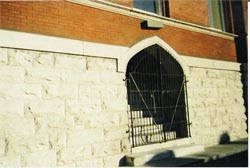
This is the backstage entrance directly across from Tootsie's Orchid Lounge.
BIBLIOGRAPHY
Randall Bedwell, ed., Unbroken Circle: A Quotable History of the Grand Ole Opry (Nashville: Cumberland House, 1999).
Bill Gaither, with Ken Abraham, It's More Than the Music: Life Lessons on Friends, Faith and What Matters Most (New York: Warner Faith, 2003).
Trish McGee, ed., Ryman Auditorium (Goodlettsville, Tennessee: Richards & Southern, Inc., 1995).
Author: Greg Freeman. Published November 1, 2006.
Randall Bedwell, ed., Unbroken Circle: A Quotable History of the Grand Ole Opry (Nashville: Cumberland House, 1999).
Bill Gaither, with Ken Abraham, It's More Than the Music: Life Lessons on Friends, Faith and What Matters Most (New York: Warner Faith, 2003).
Trish McGee, ed., Ryman Auditorium (Goodlettsville, Tennessee: Richards & Southern, Inc., 1995).
Author: Greg Freeman. Published November 1, 2006.
Copyright
Southern Edition
All Rights Reserved
Southern Edition
All Rights Reserved
All materials contained on this site, including text and images, are protected by copyright laws and may not be reproduced without prior written permission from the publisher. Where applicable, use of some items contained on this site may require permission from other copyright owners.
Fair Use of text from SouthernEdition.com is permitted to the extent allowed by copyright law. Proper citation is requested. Please use this guide when citing a Southern Edition article.
Contact Greg Freeman or SouthernEdition.comFair Use of text from SouthernEdition.com is permitted to the extent allowed by copyright law. Proper citation is requested. Please use this guide when citing a Southern Edition article.